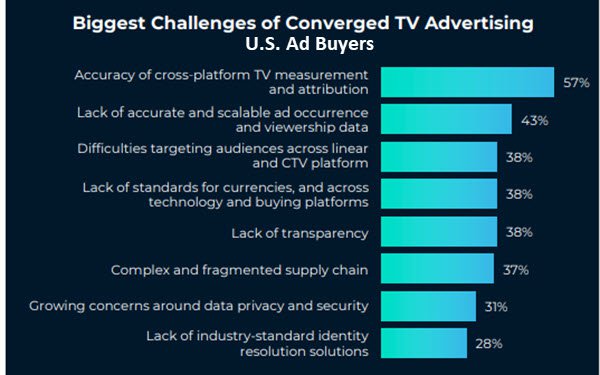by Karlene Lukovitz @KLmarketdaily
Source: www.mediapost.com, October 2021
More than 70% of media buyers in the U.S. and three other key markets agree that all forms of TV should be sold on impressions, according to the latest converged TV report from TVSquared.
The research included a survey of 300 U.S. client and agency buyers by Advertising Perceptions and Dynata surveys of buyers in the U.K., Germany and Australia (nearly 1,000 buyers in total across the surveys). In addition, ad impressions for 20 converged linear/streaming ad campaigns running on the ADvantage platform were analyzed.
Three-quarters of all marketers agreed that TV is now defined as including linear and streaming (CTV/OTT) platforms, and that legacy currencies and practices are impeding the innovation of what advertisers can do with converged TV.
Among U.S. respondents, 80% agreed that the upfronts need to be more data-driven, and 88% agreed that upfront deals need to make transacting across linear and streaming platforms more flexible and easier to transact.
Accuracy of cross-platform TV measurement and attribution was the converged TV advertising challenge most cited by U.S. buyers (57%), followed by lack of accurate and scalable ad occurrence and viewership data (43%), difficulties targeting audiences across linear and connected TV platforms (38%) and lack of standards for currencies across technology and platforms (38%) and lack of transparency (38%). (See chart top of page.)
Fewer than a third consider growing concerns around data privacy, and lack of industry standard identity resolution solutions, to be key challenges.
Asked about key factors in deciding to invest in converged campaigns, 94% deemed ability to measure incremental reach of streaming/CTV beyond linear as very or somewhat important, and 92% said the same about transparency of metrics across linear and streaming platforms.
Large percentages also view standardized cross-platform measurement, achieving scale and maintaining data precision, and other factors as important:
One in two report leveraging first- and third-party data, 36% use set-top-box data, and 31% use OEM viewership panel data. For attribution, more than 40% use online data and 34% use offline data.
As marketers are able to employ deterministic datasets that tie reach, frequency and outcomes directly to audience IDs, they are increasingly able to treat linear and streaming similarly.
More than 40% are measuring both linear and streaming for outcomes weekly, with about 10% to 15% measuring daily.
That frequency is “a huge step forward for an industry that has long been known for lag times and little flexibility in delivering and accessing insights,” notes the report.
Within OTT/CTV, 35% are optimizing campaigns for performance and 31% are optimizing creative weekly, and even within linear, 33% and 32%, respectively, now report doing the same.
“As TV becomes more flexible across channels, and as advertisers get more comfortable with balancing converged TV campaigns and leveraging apples-to-apples insights for linear and streaming, we should see an even greater majority of marketers managing TV holistically,” observes the report.
“However, given that a majority of total video spend still remains in linear, there is a lot of room for growth in terms of achieving greater reach across the total TV audience by allocating more impressions or investing more heavily in streaming platforms.”
On that front, the analysis of 20 converged campaigns found that incremental reach results ranged all the way from 2% to 80%.
However, on average, the audience overlap of linear and streaming campaigns was about 30% — meaning, of course, that on average, 70% of the audiences reached via streaming services could not be reached by linear-only campaigns.
And advertisers committing at least 10% of total TV ad impressions to OTT/CTV were found to be most likely to generate at least 15% incremental reach.




